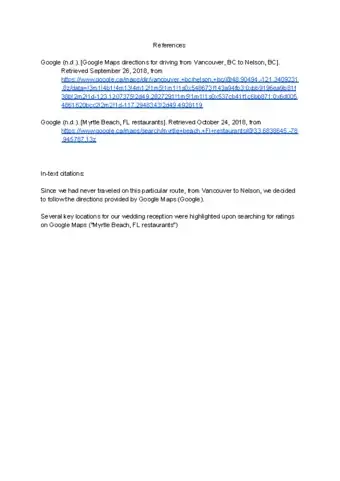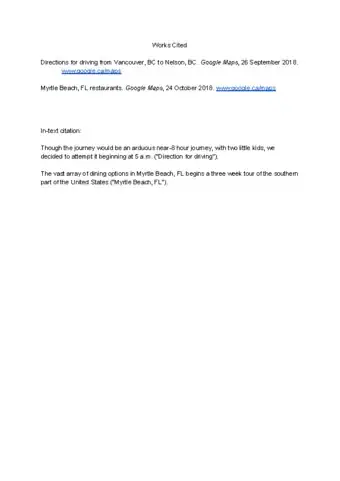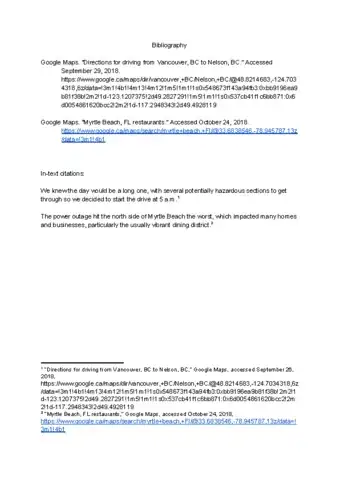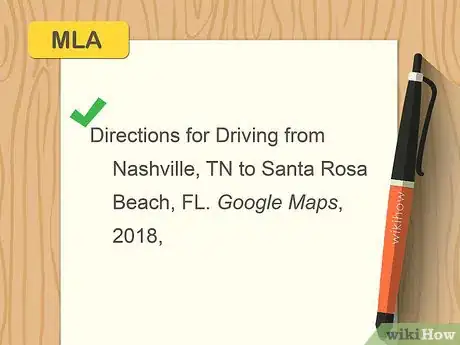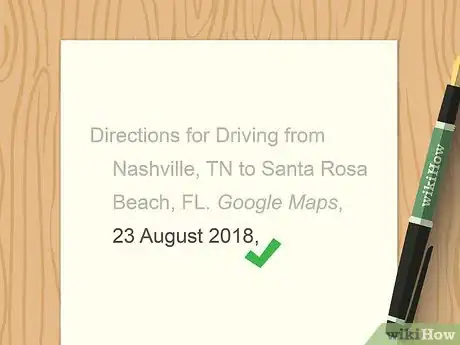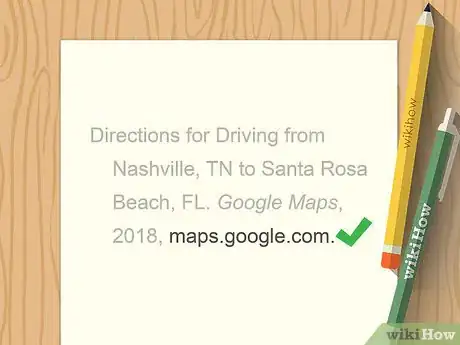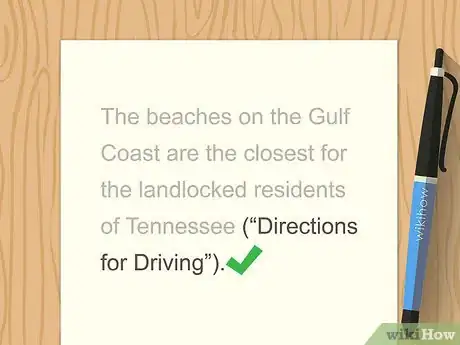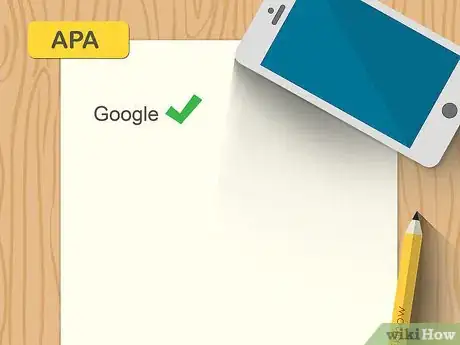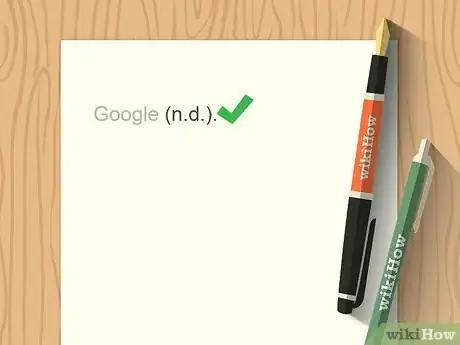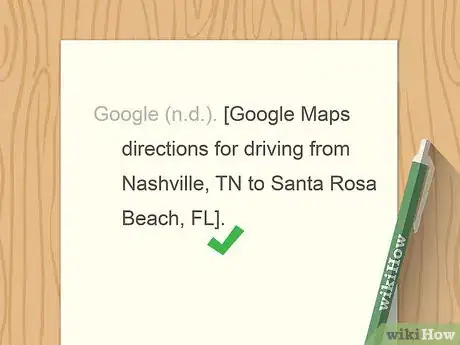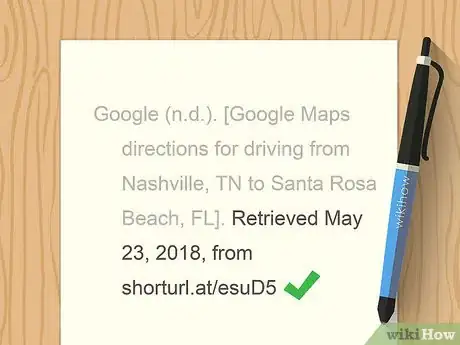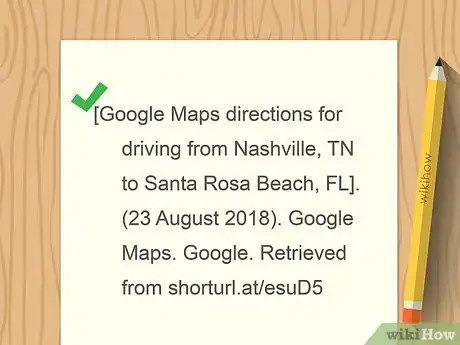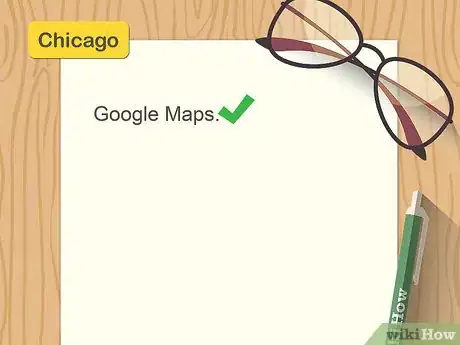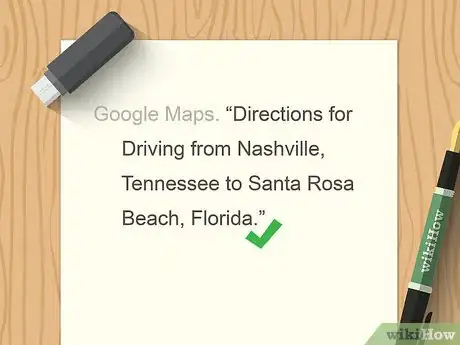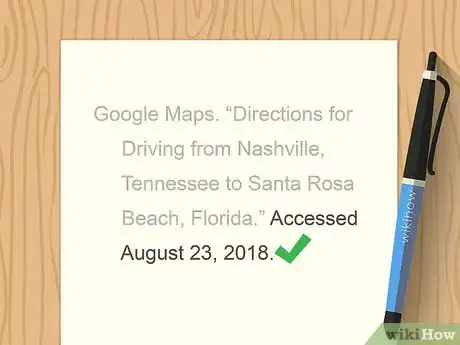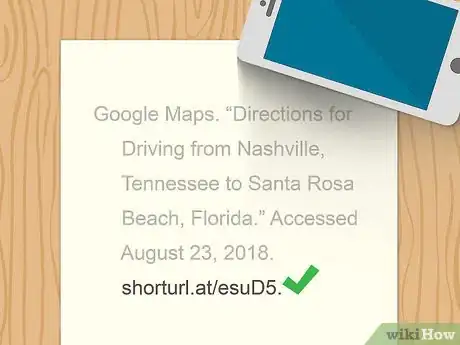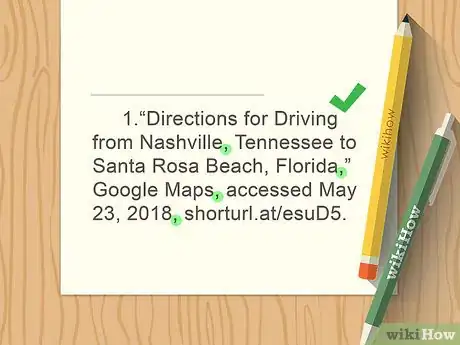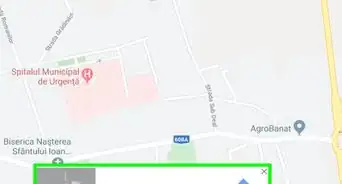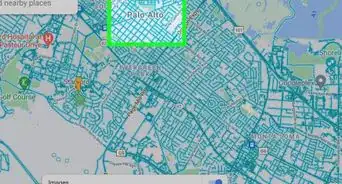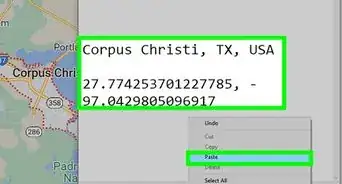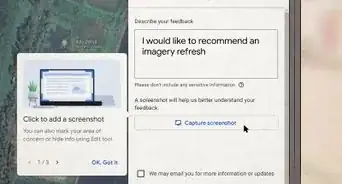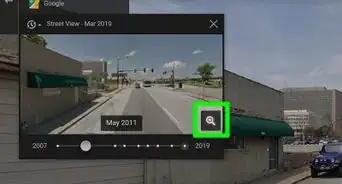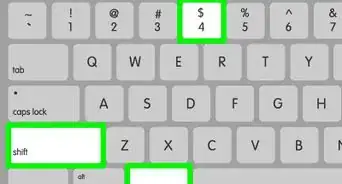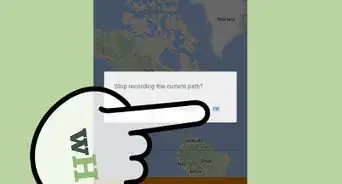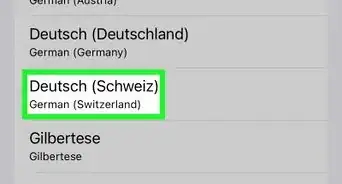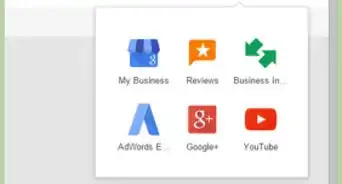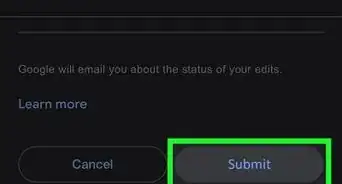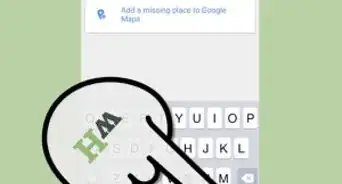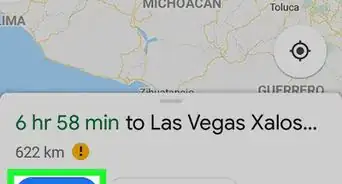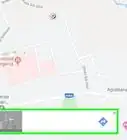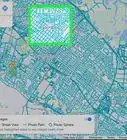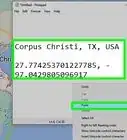This article was co-authored by wikiHow staff writer, Jennifer Mueller, JD. Jennifer Mueller is a wikiHow Content Creator. She specializes in reviewing, fact-checking, and evaluating wikiHow's content to ensure thoroughness and accuracy. Jennifer holds a JD from Indiana University Maurer School of Law in 2006.
This article has been viewed 98,953 times.
Learn more...
If you're writing a research paper or report, you might want to cite Google Maps to discuss a particular location or configure a route between two places. Most common methods of citation don't address specifically how to cite Google Maps. Instead, you have to cobble together a format using the requirements for online maps generally. While you're typically going to include the same basic information in your citation, the formats for Modern Language Association (MLA), American Psychological Association (APA), and Chicago style are slightly different.
Things You Should Know
- If you need to cite Google Maps, make sure to truncate lengthy URLs.
- For MLA format, include a shortened title or description in-text.
- For APA format, use Google as the author.
Steps
Sample Citations
MLA
-
1Start with a title or description of the map. Google Maps may not necessarily give you a specific title for the map, so you'll typically have to make this up on your own. The title should be descriptive of what the map shows. Place a period after your title.[1]
- Location example: Map of Santo Domingo, Dominican Republic.
- Route example: Directions for Driving from Nashville, TN to Santa Rosa Beach, FL.
-
2Identify the source of the map. After the title or description of the maps, type "Google Maps" in italics to let your readers know where the map was found. Place a comma after the name of the source, then provide the year the map was produced. Place a comma after the year.[2]
- Example: Directions for Driving from Nashville, TN to Santa Rosa Beach, FL. Google Maps, 2018,
Advertisement -
3Provide a specific date if required. Some instructors or supervisors may want you to provide the exact date you created the map you're citing. In this case, provide the full date in day-month-year format in place of the year[3]
- Example: Directions for Driving from Nashville, TN to Santa Rosa Beach, FL. Google Maps, 23 August 2018,
-
4Truncate lengthy URLs. If you search for a route on Google Maps, you will likely end up with a URL that spans several lines. Rather than copying this URL, simply use the site's root URL. The reader can search for the specific content on their own. Place a period after the URL.[4]
- Example: Directions for Driving from Nashville, TN to Santa Rosa Beach, FL. Google Maps, 2018, maps.google.com.
-
5Include a shortened title or description in-text. MLA in-text citations are based on the first element listed in the entry in your "Works Cited." Typically, this is the author's name. In this case, it will be a title or description of the map you produced with Google Maps. Use the first few words of that title, in quotation marks, to direct your readers to the entry in your "Works Cited."[5]
- Example: ("Directions for Driving")
APA
-
1Use Google as the author. A full APA citation in your reference list would start with the name of the author. Since Google Maps is a service provided by Google, list Google as the author of the source. Place a period after the name.[6]
- Example: Google.
-
2Indicate no date for the publication date. The next part of an APA citation is the date of publication in parentheses. However, because pages in Google Maps are created on demand, they don't have a set publication date. Use the abbreviation "n.d." enclosed in parentheses. Place a period after the closing parentheses.[7]
- Example: Google (n.d.).
-
3Create a description in square brackets. The next part of your APA citation would be the title of the source. However, Google Maps don't have titles. Instead, type an adequate description of the map. Put your description in square brackets to indicate that it is a description, not a title. Use sentence-case, capitalizing only the first word and any proper nouns in your description. Place a period outside the closing bracket.[8]
- Example: Google (n.d.). [Google Maps directions for driving from Nashville, TN to Santa Rosa Beach, FL].
-
4Provide the date you produced the map and a direct URL. APA doesn't typically require retrieval dates for online sources. However, in this case a retrieval date is appropriate since driving directions could change at any time, and because the map was produced on demand.[9]
- Example: Google (n.d.). [Google Maps directions for driving from Nashville, TN to Santa Rosa Beach, FL]. Retrieved August 23, 2018, from shorturl.at/esuD5
- Note that you will typically end up with a long URL. Talk to your instructor or supervisor about this, and get their recommendations for shortening or truncating the URL.
-
5Try an alternative method of citation. The libraries at the University of Texas, Arlington have a different citation method for Google Maps that places the description first and uses the date you produced the map as the publishing date. Present this alternative to your instructor or supervisor and see which one they prefer.[10]
- Example: [Google Maps directions for driving from Nashville, TN to Santa Rosa Beach, FL]. (23 August 2018). Google Maps. Google. Retrieved from shorturl.at/esuD5
-
6Augment the author-date parenthetical to suit your citation. When referencing the map in your paper, try to provide enough description in the text that your readers could find the full citation in your reference list with just the author listed. Alternatively, you could also use a shortened version of the title or description in your parenthetical.[11]
- Author example: "Google Maps shows that it would take between 7 and 8 hours to drive from Nashville, TN to Santa Rosa Beach, FL (Google)."
- Description example: "The beaches on the Gulf Coast are the closest for the landlocked residents of Tennessee ("Google Maps driving directions").
Chicago
-
1Use Google Maps as the author in your bibliography entry. For the full citation to the map you pulled up on Google Maps, use the title of the source of the map. Place a period at the end of this part of your citation.
- Example: Google Maps.
-
2Put a description of the map in quotation marks. After the source of the map, create a description that accurately reflects the map you produced. Use title-case, capitalizing all key words including nouns, pronouns, adjectives, verbs, and adverbs. Place a period at the end, inside the closing quotation marks.
- Example: Google Maps. "Directions for Driving from Nashville, Tennessee to Santa Rosa Beach, Florida."
-
3Provide the date you accessed or produced the map. After your description, type the word "Accessed" and then the date you searched for and produced the map. Use month-day-year format for the date. Place a period at the end.
- Example: Google Maps. "Directions for Driving from Nashville, Tennessee to Santa Rosa Beach, Florida." Accessed August 23, 2018.
-
4End your bibliographic citation with a full URL for the map. For Chicago style, it isn't recommended that you shorten or truncate the URL for the map, regardless of how long it is. However, it's a good idea to ask your instructor or supervisor if they would prefer a shortened URL, to keep it from junking up your references. Place a period at the end of the URL to close your citation.
- Example: Google Maps. "Directions for Driving from Nashville, Tennessee to Santa Rosa Beach, Florida." Accessed August 23, 2018. shorturl.at/esuD5.
-
5Start footnotes with the description and use commas. When citing the map in the body of your paper or report, switch the position of the description (title) and source (author). Separate each element of the citation with a comma rather than a period. Place a period only at the end.
- Example: "Directions for Driving from Nashville, Tennessee to Santa Rosa Beach, Florida," Google Maps, accessed August 23, 2018, shorturl.at/esuD5.
References
- ↑ http://libguides.uta.edu/maps/citingmaps
- ↑ https://style.mla.org/citing-a-map/
- ↑ http://libguides.uta.edu/maps/citingmaps
- ↑ https://style.mla.org/citing-a-map/
- ↑ https://libguides.williams.edu/citing/mla#s-lg-box-11358746
- ↑ http://blog.apastyle.org/apastyle/2015/08/how-to-cite-online-maps.html
- ↑ http://blog.apastyle.org/apastyle/2015/08/how-to-cite-online-maps.html
- ↑ http://blog.apastyle.org/apastyle/2015/08/how-to-cite-online-maps.html
- ↑ http://blog.apastyle.org/apastyle/2015/08/how-to-cite-online-maps.html
